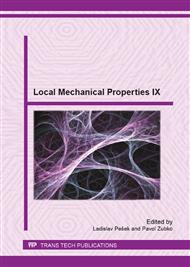p.150
p.154
p.158
p.162
p.166
p.170
p.174
p.178
p.182
Mechanical Properties of Porous Si3N4 Ceramics
Abstract:
Mechanical properties of porous silicon nitride prepared by two different processing routes have been studied. Depth sensing methods was used to measure the hardness and elastic modulus of experimental materials. The results were compared with the hardness and elastic modulus of trabecular bone in order to find out porous ceramics with properties close to that of trabecular bone. Material prepared by infiltration of polyurethane sponge exhibited properties close to the properties of bone and it is the potential material for further investigation in the bioapplication field.
Info:
Periodical:
Pages:
166-169
Citation:
Online since:
September 2013
Keywords:
Price:
Сopyright:
© 2014 Trans Tech Publications Ltd. All Rights Reserved
Share:
Citation:


